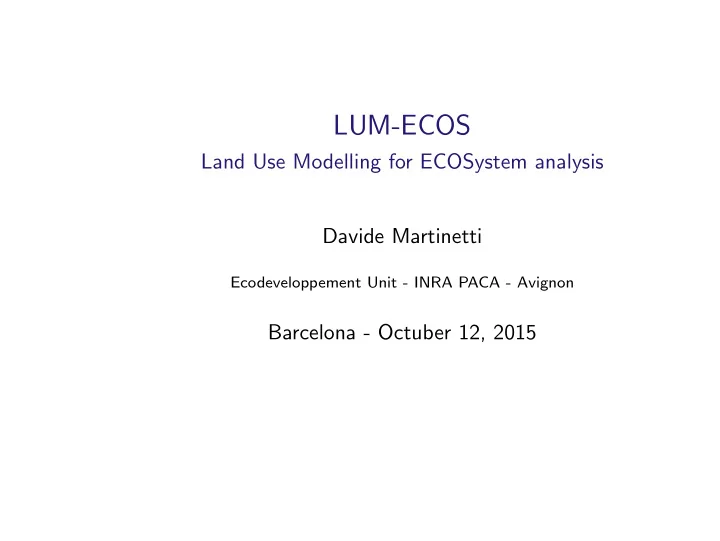

LUM-ECOS Land Use Modelling for ECOSystem analysis Davide Martinetti Ecodeveloppement Unit - INRA PACA - Avignon Barcelona - Octuber 12, 2015
Objective of the project Understanding the link between land-use and the presence/dissemination of micro-organisms in the atmosphere. Facts: ◮ Many types of microorganisms (MO) circulate in the atmosphere via clouds and precipitation; ◮ Land use is responsible of the concentration and vertical flux of MO’s at ground level; ◮ Airborne MO can be pathogens and can have an impact on the climate via bio-precipitation. 2 / 10
Land use effects on MO concentration and flux The land cover is key for quantifying the concentration and ver- tical flux of MO in the atmosphere ◮ presence of tree canopies ◮ crop ◮ forest ◮ grassland ◮ etc. ◮ physical characteristics ◮ altitude ◮ exposition ◮ humidity and presence of water/rain ◮ temperature/seasonality ◮ etc. ◮ effects derived from agricultural practices ◮ irrigation ◮ pesticides ◮ etc. 3 / 10
Land Use Modelling - LUM Land Use modelling is used in our project to forecast land use changes in the middle term (10-15 years) in the PACA region. 4 / 10
LUM in PACA We have access to a huge database ( > 5 million observations) at parcel-level scale, with socio-economic, geographical and agri- cultural explanatory variables. The LUM aims to explain the land use in each parcel according to the observed features, but also considers potential spatial spillover effects in neighbouring parcels. For this part we are using a Spatial Autoregressive Probit Model. 5 / 10
LUM - Spatial Dependence 6 / 10
ECOS - Diffusion of MO and their potential effect The objective is to predict the dissemination patterns of airborne MO and to study their impact on plant health and climate. 7 / 10
Estimated MO concentration 1 Ecosystem Best estimate Low estimate High estimate 7 . 6 × 10 4 2 . 3 × 10 4 1 . 3 × 10 5 coastal 1 . 1 × 10 5 4 . 1 × 10 4 1 . 7 × 10 5 crops 1 . 6 × 10 2 3 . 8 × 10 4 deserts 5 . 6 × 10 4 3 . 3 × 10 4 8 . 8 × 10 4 forests 1 . 1 × 10 5 2 . 5 × 10 4 8 . 4 × 10 5 grasslands 1 × 10 4 land ice 1 × 10 4 1 × 10 1 8 × 10 4 seas 3 . 5 × 10 5 1 . 2 × 10 4 8 . 4 × 10 5 shrubs 1 . 2 × 10 4 5 . 6 × 10 4 tundra 9 × 10 4 2 × 10 4 8 × 10 5 wetlands 6 . 5 × 10 5 4 . 4 × 10 5 9 . 2 × 10 5 urban 1 . 2 × 10 5 4 . 8 × 10 4 1 . 9 × 10 5 urban park Table: Estimates of total mean bacterial concentration in near-surface air of various ecosystem types (units per m − 3) 1 Burrows et al. Bacteria in the global atmosphere. Atmos. Chem. Phys. 2009. 8 / 10
ECOS - Effect of MO in the Ecosystem By studying the specific case of the bacteria Pseudomonas Sy- ringae , we will try to assess: ◮ the potential diffusion of pests via atmospheric transportation ◮ the effect on precipitation and climate 9 / 10
Conclusions For more details, contact me during the poster session! Thank you for you attention. 10 / 10
Recommend
More recommend